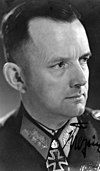This article has multiple issues. Please help improve it or discuss these issues on the talk page. (Learn how and when to remove these messages)
|
| 8th Army | |
|---|---|
| German: 8. Armee | |
 Hitler and his generals watching 8th army parading in the Poland campaign Hitler and his generals watching 8th army parading in the Poland campaign | |
| Active | 1939; 1943-1945 |
| Country | |
| Branch | |
| Type | Field army |
| Size | 30 August 1943 (start of the Battle of the Dnieper): 159,598 7 April 1944 (Dnieper-Carpathian Offensive): 230,000 |
| Engagements | World War II |
The 8th Army (German: 8. Armee) was a World War II field army. It existed twice during the war, in the invasion of Poland in 1939, and on the Eastern Front from 1943 onwards.
The 8th Army was activated on 1 August 1939 with General Johannes Blaskowitz in command. In 1939 it was part of Gerd von Rundstedt's Army Group South for the Invasion of Poland. It consisted of two corps, X. Armeekorps and XIII. Armeekorps, and was responsible for the northern part of Army Group South's front. The army saw heavy combat during the Battle of the Bzura. After the conclusion of the Polish campaign, it was reorganized into the 2nd Army which took part in the Battle of France in 1940.
In 1943 it was reformed after the Battle of Kursk from Army Detachment Kempf. After fierce defensive battles throughout 1943, 1944 and the first months of 1945, it finally surrendered in Austria in 1945. It fought in Hungary, Romania, and Austria in 1944 and 1945.
Commanders
| No. | Portrait | Commander | Took office | Left office | Time in office |
|---|---|---|---|---|---|
| 1 |
 | Blaskowitz, JohannesGeneraloberst Johannes Blaskowitz (1883–1948) | 1 August 1939 | 20 October 1939 | 80 days |
| 2 |
 | Wöhler, OttoGeneral der Infanterie Otto Wöhler (1894–1987) | 22 August 1943 | 7 December 1944 | 1 year, 107 days |
| 3 |
 | Kreysing, HansGeneral der Gebirgstruppe Hans Kreysing (1890–1969) | 28 December 1944 | 8 May 1945 | 131 days |
References
- Citations
- Übersicht über den Zustand der Divisionen und gep. Einheiten der 8. Armee. Stand: 30.8.43. Anlage zu A.O.K. 8 Ia Nr. 1511/43 g.Kdos. Bundesarchiv-Militärarchiv (BA-MA) RH 20-8/9.
- H Gr. A/Südukraine 64801/8. Anlage 1159 zum Kriegstagebuch Nr. 7 d. Oberkdos. d. H. Gr. Süd/O.Qu. Wirtschaftsverhandlungen Rumänien. Verpflegungsstärken (am 7 April 1944), Raum I (8. Armee). NARA T312, R64, F7195911.
- Sources
- Tessin, Georg. "Die Landstreitkräfte 6—14" [Armies 6 - 14]. Verbände und Truppen der deutschen Wehrmacht und Waffen SS im Zweiten Weltkrieg 1939—1945 (in German). Vol. 3. Frankfurt/Main: E.S. Mittler. pp. 87–90.
| Armies of the German Army in World War II | |||||||||||||
|---|---|---|---|---|---|---|---|---|---|---|---|---|---|
| Armies |
| ||||||||||||
| Panzer | |||||||||||||
| Parachute | |||||||||||||
This German World War II article is a stub. You can help Misplaced Pages by expanding it. |